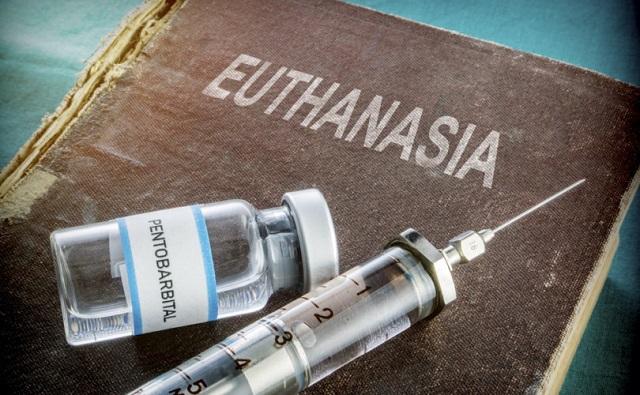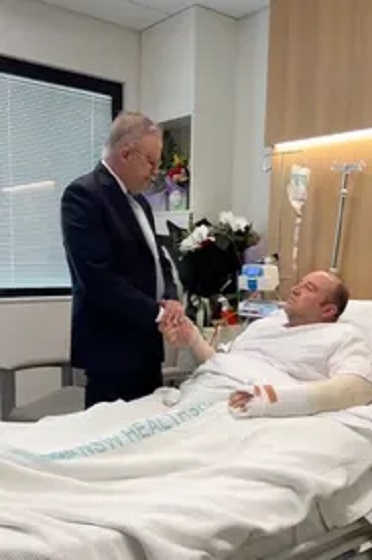MAiD
Official data shows euthanasia deaths in Canada rose significantly in 2023

From LifeSiteNews
Medical Assistance in Dying (MAiD) increased 42% in 2023 in Quebec alone.
Deaths of Canadians by state-approved euthanasia have risen sharply in most provinces according to recent data, with approximately 16,000 people dying in 2023 alone, a significant increase from 2022 and an “out of control” rate, the nation’s leading anti-euthanasia advocacy group warned.
Official MAiD data from Ontario, Quebec, and Alberta shows the shocking level of deaths. In 2022, there were 13,241 Canadians who died by MAiD.
According to data from the Quebec Commission on End-of-Life Care’s eighth annual report, 5,211 people died by MAiD from April 1, 2022, to March 31, 2023, which is a large increase from 3,663 in the previous reporting period.
Alex Schadenberg, executive director of the Euthanasia Prevention Coalition (EPC), wrote in a recent blog that he predicts that 60,000 Canadians have died by MAiD since the deadly practice was legalized in 2016, with the rate increasing every year.
“Euthanasia is out of control in Canada,” Schadenberg said.
The EPC noted that deaths in Quebec from MAiD increased 42% in 2023, accounting for 6.8% of all deaths in the province. The report also shows that from April 1 to June 30, 2023, the number of MAiD deaths in the province went up 24%, which the EPC noted is “a slower pace of growth, but substantial considering the massive number of euthanasia deaths.”
The EPC also reflected that “Shockingly, 15% of those who died by euthanasia in Quebec were not terminally ill.”
MAiD data from Ontario released late last year shows there were 4,641 deaths in 2023, an 18% increase from 3,924 in 2022.
Data from Alberta shows that since June 2016 there have been 3,914 reported deaths by MAiD. However, 977 were in 2023, which is an 18% increase from 836 in 2022, or 594 in 2021.
Most MAiD deaths in Canada are done by a “doctor or nurse injecting a person, usually upon request, with a lethal poison cocktail,” the EPC noted.
Assisted suicide, the EPC says, is much less common and “is done by a doctor or nurse prescribing a person, usually upon request, a lethal poison cocktail that the person would take themselves.”
Last week, notably after pushback from pro-life, medical, and mental health groups as well as most of Canada’s provinces, the federal government under Prime Minister Justin Trudeau delayed its planned expansion of euthanasia to those suffering solely from mental illness to 2027.
Canadian Health Minister Mark Holland and Justice Minister Arif Virani announced the delay but said the government is still fully committed to expanding MAiD.
The delay was welcomed by the Euthanasia Prevention Coalition, but Schadenberg told LifeSiteNews that euthanasia “should be scrapped altogether.”
“We will be active in the next election reminding voters of the Members of Parliament who voted against Bill C-314 last fall, a bill that would have scrapped euthanasia for mental illness,” Schadenberg said.
Campaign Life Coalition (CLC) said that Canadians need “compassionate care, not killing,” and has urged Trudeau’s federal government to permanently scrap, not just delay, its planned expansion of euthanasia to those suffering from mental illness.
The Conservative Party of Canada (CPC) under leader Pierre Poilievre is supportive of the pause but wants the expansion of MAiD to be dropped altogether.
The CPC has opposed the expansion of MAiD, but recent attempts to stop the grim procedure, such as through Bill C-314, have failed.
The current delay is the second time the expansion has been put on hold.
Originally set to go into effect in March 2023, pressure from the same groups led the Liberals under Trudeau to delay Bill C-39.
The original delay in expanding MAiD until 2024 also came after numerous public scandals, including the surfacing of reports that Canadian veterans were being offered the fatal procedure by workers at Veterans Affairs Canada (VAC).
Great Reset
Viral TikTok video shows 7-year-old cuddling great-grandfather before he’s euthanized

From LifeSiteNews
Karly Vavra, the little girl’s mother, told People that she chose to share the video in order to honor her grandfather—but also to normalize euthanasia.
A video of a 7-year-old girl sharing a “final cuddle” with her great-grandfather before he is euthanized has gone viral on TikTok, racking up millions of views.
@karlsbergggg Sobbing 😭 #MAID #medicallyassisteddeath #grandpasgirl #greatgrandpa #greatgrandparents
The video shows the child curled up next to an elderly man, sitting straight on the couch, their final moments together captured. “This is my 96 year old grandpa with my 7 year old,” the caption reads. “He’s doing MAID soon. I tried explaining gently to my daughter that this was the last visit she’d have with him. This is what she did the second she walked in. He’s so happy.”
Karly Vavra, the little girl’s mother, told People that she chose to share the video in order to honor her grandfather—but also to normalize euthanasia. “The feeling is very bittersweet,” she said. “I look back with smiles and tears.” She admitted that she knows “my daughter didn’t fully understand these were her last moments with him.”
Her grandfather, who had chosen euthanasia, did understand the gravity of the moment. “My grandpa knew those were his last moments with her,” Vavra said. “Him looking down in that short moment, I believe, was his way of trying to hide emotions as he was a very proud man.” Her grandfather was scheduled to be killed by lethal injection just days later.
READ: Glenn Beck offers to fund life-saving surgery for Canadian woman approved for euthanasia
Vavra says her grandfather was always a favorite of neighborhood children, who were drawn to him. “I am so grateful both my kids got to know him, though, as not many children get [much] time, if any, with a great grandparent,” she said. “My grandpa was honestly the sweetest man. He loved children, gardening, golf, music and was VERY opinionated… Him and my kids were always laughing with each other, and he loved how loud and proud my daughter was! I hope she is strong like he was and always laughs and sees the brighter side.”
Vavra posted the video because she wanted to celebrate her grandfather’s euthanasia. “I posted this because I truly believe MAID can be a wonderful thing,” she told People. “Letting people go the way they want, with dignity, and not suffering… A lot of religions don’t believe in MAID and some comments were more aggressive than others. Seeing how negative some of the responses were made me really want to advocate for the MAID program.”
“Her connection to MAID began long before her own grandparents made their decisions, as she previously worked on a case in British Columbia after she says many of her coworkers opted not to participate,” People reported.
“I am a very open, understanding person and believe in ‘your body your choice’ which is why I volunteered,” she says...This year alone brought unimaginable loss for her family. “My parents and aunt have had a harder time because both their mom and dad decided to do MAID this year, so it’s definitely been a rough year, but we are sticking together as a family and really trying to cherish all our moments together,” Karly shares.
There are over 10,000 comments on Vavra’s TikTok video, many of them expressing horror at the normalization of putting elderly people to sleep like sick household pets.
“I always try to be honest with my children,” Vavra said. “I explained that Big Papa (what my kids called him) was in a lot of pain and that he would be going to meet Big Grandma on Saturday (my grandma also did MAID this year). I explained that a very nice doctor and nurses were coming and they were going to give him some medicine and he would fall into the best sleep ever but forever, and that he wouldn’t be in pain anymore.”
It is notable that despite the irreligious basis of euthanasia, spiritual language is often incorporated into euthanasia conversations in order to soften the reality of what is taking place.
This is a new Canadian reality: Children losing their parents, grandparents, and great-grandparents not to natural death, but to lethal injections. Their goodbyes are defined by moments that do not have to be the last but have been chosen. There could have been more conversations. More cuddles. More love. But there was not—and that was a decision. “Seeing her link arms with him was very touching but of course very painful,” Vavra said. “Both loving each other so much. I wish we could have had him forever.”
They could have had him longer.
International
Trump admin wants to help Canadian woman rethink euthanasia, Glenn Beck says

From LifeSiteNews
Jolene Van Alstine, approved for state-sanctioned euthanasia after enduring long wait times to receive care for a rare parathyroid disease, is in need of a passport to enter the U.S.
Well-known American media personality Glenn Beck says he has been in touch with the U.S. State Department to help a Canadian woman in Saskatchewan reconsider euthanasia after she sought assisted suicide due to long medical wait times to address her health problems.
As reported by LifeSiteNews on Tuesday, Canadian woman Jolene Van Alstine was approved to die by state-sanctioned euthanasia because she has had to endure long wait times to get what she considers to be proper care for a rare parathyroid disease.
Van Alstine’s condition, normocalcemic primary hyperparathyroidism (nPHPT), causes her to experience vomiting, nausea, and bone pain.
Her cause caught the attention of Beck and many other prominent Americans and Canadians on X.
In an update today on X, Beck said, “Jolene does not have a passport to gain legal entry into the U.S., but my team has been in touch with President (Donald) Trump’s State Department.”
“All I can say for now is they are aware of the urgent life-saving need, and we had a very positive call,” he added.
Beck had said before that he was in “contact with Jolene and her husband” and that he had “surgeons who emailed us standing by to help her.”
As of press time, neither the State Department nor other officials have not yet confirmed Beck’s claim that he has been in touch with them.
As a result of Van Alstine’s frustrations with the healthcare system, she applied for Canada’s Medical Assistance in Dying (MAiD) and was approved for January 7.
As reported by LifeSiteNews, over 23,000 Canadians have died while on wait lists for medical care as Prime Minister Mark Carney’s Liberal government is focused on euthanasia expansions.
A new Euthanasia Prevention Coalition report revealed that Canada has euthanized 90,000 people since 2016, the year it was legalized.
As reported by LifeSiteNews recently, a Conservative MP’s private member’s bill that, if passed, would ban euthanasia for people with mental illness received the full support of the Euthanasia Prevention Coalition.
-

 Business2 days ago
Business2 days agoSome Of The Wackiest Things Featured In Rand Paul’s New Report Alleging $1,639,135,969,608 In Gov’t Waste
-

 Energy2 days ago
Energy2 days ago‘The electric story is over’
-

 Alberta1 day ago
Alberta1 day agoOttawa-Alberta agreement may produce oligopoly in the oilsands
-

 Alberta2 days ago
Alberta2 days agoA Christmas wish list for health-care reform
-

 Energy1 day ago
Energy1 day agoWestern Canada’s supply chain for Santa Claus
-

 Energy1 day ago
Energy1 day agoThe Top News Stories That Shaped Canadian Energy in 2025 and Will Continue to Shape Canadian Energy in 2026
-

 International1 day ago
International1 day ago$2.6 million raised for man who wrestled shotgun from Bondi Beach terrorist
-

 armed forces9 hours ago
armed forces9 hours agoRemembering Afghanistan and the sacrifices of our military families










